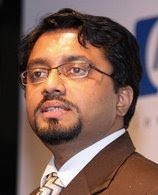Thursday, January 28, 2010
Monday, January 18, 2010
What counts for a successful IT project
Today i was reading this article when I came across a very thought provoking comment from Hemant Kogekar. On the subject of great universal lies, he says, I quote,
17. Project success is being on time, on quality and on budget
“As we all know, a project is successful only when the business gets the promised benefits.”
UNQUOTE
Those of us who have spent time in IT and Projects would know of the number of times success criteria has been defined as above, on time, on quality, on budget.
And yet, business never even blinked when a new release was operationalised in IT. More often it has been shouting when projects ever slightly tweak the user interface / service delivery to adopt the new release - discounting the opportunity / benefits that has been envisaged in the project.
Isn't it time we all started to define the measurement of a project by business outcome? How will you measure success of a project?
Friday, January 8, 2010
Its 4C: No more no less - company, channel, customer and competitor
Today I read this interesting and "almost" convincing article in Fortune. It made my resolve stronger in the view that we need to look at the overall company strategy from all the four perspectives.
Over emphasis on any one may lead you towards a direction that is too skewed. It takes away the balance. So whether Customer Is King or Competitor is the true measure of Customer Shift is not the only question to be evaluated.
What is the Route to Market strategy with the channel?
And the last but the most important, what is the core values and strategy that the company wants to drive.
I would like to hear from my learned friends on this aspect.
Friday, January 1, 2010
Bill & Dave by Michael S. Malone - Book Review
I learnt,
1. Bill overcame Dyslexia by memorising whatever he heard in class. That made a great entrepreneur - one who listens to his customers and employees.
2. Dave Packard developed the management style "Managing By Walking Around". MBWA.
3. The first product was not named product code number 1 but was 200A. The famous calculate HP-35 was named so since it had 35 keys. And interestingly the HP01 as a product was not successful at all - a Digital Watch. And the first product pricing at $54.40 was as a result of the fact that it reminded amusingly of te historic phrase "54'40" or Fight!" that was used in the 1844 camapign to set the US-Canadian border in the Northwest.
4. Friday Dressing, Beer after work on Fridays, Flex timing, telecommuting, Open Door Policy were all pioneered in HP.
5. Strong Financials of HP owe their fundamentals to "Internal Financing of Growth".
7. Treatment for Employees - being fair: Employee Evaluations and Termination
- The indivdual affected had had advance warning through written evaluation and has been advised constructively on how he/she should improve.
- Wherever practical assure the employee is given an opportunity for other placement where he/she might make a greater contribution. Employee placement is a functino of supervisors and personnel and not a function of the emplyee to be turned loose to find a his own job someplace in HP.
- If termination is the only alternative, personnel must be fully advised and believe the fase is satisfactorily documented and the decision has the approval of the general manager concerned.
- Before any adverse action is taken, it should be well thought out. We must recongise that each of our people represents an individual with problems, families etc.
8. The Nine Day Fortnight - It is only fair that, during hard times everyone in the company share in the pain and make comparable sacrifices.
and finally ...
1. Profit: profit is the best single measure of our contribution to society and te ultimate source of our corporate strength. aimt to achieve maximum possible profit consistent with our other objectives.
2. Customers: to strive for continuous improvement in the quality, usefulness, and value fo the products, and services we offer our customers.
3. Field of Interest: to concentrate our efforts continually seeking new opportunities for growth but limiting our involvement to fields in which we have capability and can make contributions
4. Growth: To emphasize graoth as a measure of strength and a requirement for survival.
5. Employees: To provide employment opportunities for HP people that include the opportunity to share in the company's success which they help make possible. To provide for them job security based in perforamnce and to provide the opportunity for personal satisfaction that comes from a sense of accomplishment in their work.
6. Organisation: To maintain an organisational environment that fosters individual motivation, intiative, creativity, and wide latitude of freedom in working towards established objectives and goals.
7. Citizenship: To meet obligations of good citizenship by making contributions to the community and to the institutions in our society whcih generate the environment in which we operate.
